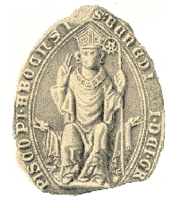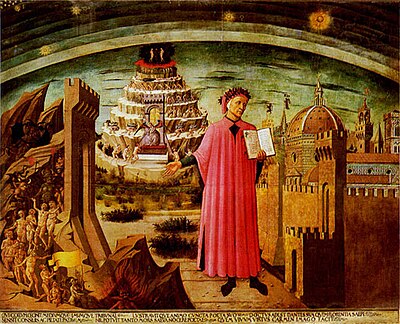Portal:Middle Ages
The Middle Ages portal

In the history of Europe, the Middle Ages or medieval period (also spelt mediaeval or mediæval) lasted approximately from 500 AD to 1500, although some prefer other start and end dates. The Middle Ages is the second of the three traditional divisions of Western history: antiquity, medieval, and modern. Major developments include the predominance of agriculture in the economy, the exploitation of the peasantry, slow interregional communication, the importance of interpersonal relations in power structures, and the fragility of state bureaucracy. The medieval period is itself sometimes subdivided into the Early, High, and Late Middle Ages, and the early medieval period is alternatively referred to as the Dark Ages.
Population decline, counterurbanisation, the collapse of centralised authority, the mass migration of tribes (mainly Germanic peoples), and Christianisation, which had begun in late antiquity, continued into the Early Middle Ages. The movements of peoples led to the disintegration of the Western Roman Empire, and the rise of new kingdoms. In the post-Roman world, taxation declined, the army was financed through land grants, and the blending of Later Roman civilisation and the invaders' traditions is well documented. The Eastern Roman Empire (or Byzantine Empire) survived but lost the Middle East and North Africa to Muslim conquerors in the 7th century. Although the Carolingian dynasty of the Franks reunited much of the Western Roman lands by the early 9th century, the Carolingian Empire quickly fell apart into competing kingdoms, which later fragmented into autonomous duchies and lordships.
During the High Middle Ages, which began after 1000, the population of Europe increased greatly as the Medieval Warm Period allowed crop yields to increase, and technological and agricultural innovations introduced a "commercial revolution". Slavery nearly disappeared, and peasants could improve their status by colonising faraway regions in return for economic and legal concessions. New towns developed from local commercial centers, and urban artisans united into local guilds to protect their common interests. Western church leaders accepted papal supremacy to get rid of lay influence, which accelerated the separation of the western Catholic and eastern Orthodox Churches, and triggered the Investiture Controversy between the papacy and secular powers. With the spread of heavy cavalry, a new aristocracy emerged who stabilised their position through strict inheritance customs. In the system of feudalism, the noble knights owed military service to their lords in return for the lands they had received in fief. Stone castles were built in regions where central authority was weak but by the end of the period state power was in the rise. The Western European peasants' and aristocrats' movement towards the peripheries of Europe, often in the guise of crusades, led to the expansion of Latin Christendom against the neighbouring Muslim, pagan, and Orthodox peoples. The spread of cathedral schools and universities stimulated a new method of intellectual discussions, with an emphasis on rational argumentation, known as scholasticism. Mass pilgrimages prompted the construction of massive Romanesque churches, while structural innovations led to the development of the more delicate Gothic architecture.
Difficulties and calamities, including a great famine and the Black Death, which reduced the population by 50 per cent, introduced the Late Middle Ages in the 14th century. Conflicts between ethnic and social groups intensified, and local conflicts often escalated into full-scale warfare, such as the Hundred Years' War. By the end of the period, the Byzantine Empire and the Balkan states were conquered by a new Muslim power, the Ottoman Empire, whereas in the Iberian Peninsula, the Christian kingdoms won their centuries-old war against their Muslim neighbours. The prominence of personal faith is well documented, but the Western Schism and dissident movements condemned as heresies presented a significant challenge to traditional power structures in the Western Church. Humanist scholars started to put a special emphasis on human dignity, and Early Renaissance architects and artists revived several elements of classical culture in Italy. During the last medieval century, naval expeditions in search for new trade routes introduced the Age of Discovery. (Full article...)
Selected article
Selected biography

Saint Henry (pyhä Henrik or piispa Henrik in Finnish, Biskop Henrik or Sankt Henrik in Swedish, Henricus in Latin; died allegedly 20 January circa 1156) was a medieval English clergyman. He came to Sweden with cardinal Nicholas Breakspeare in 1153 and was probably designated to the new Archbishop of Uppsala, but the independent church province of Sweden could be established only in 1164 after the civil war was over, and Henry would have been sent to organize the Church in Finland, where Christians had existed already at least two centuries. According to legends, he entered Finland together with King Eric the Saint of Sweden and died as a martyr, becoming a central figure in the local Roman Catholic Church. However, the authenticity of the accounts of his life, ministry, and death are widely disputed.
Together with his alleged murderer Lalli, Henry remains one of the most recognized people from the early history of Finland. His feast is celebrated by the Roman Catholic Church of Finland, and he is commemorated in several Protestant liturgical calendars. (Read more. . .)
Did you know...
- ...that a paillasse is a thin mattress filled with hay or sawdust and was commonly used in the middle ages?
- ...that a barbican is a tower or other fortification defending the drawbridge, usually the gateway?
- ...that a coif is a type of armored head-covering made out of chain-mail and worn under the helmet for extra protection?
- ...that a heriot is a payment owed to the lord of the manor by a serf’s family upon the serf’s death; usually the family’s best animal, such as a cow, horse or most commonly ox?
- ...that before 1066, it was noted in the Domesday Book, if one Welshman killed another, the dead man’s relatives could exact retribution on the killer and his family (even burning their houses) until burial of the victim the next day?
- ...that buboes are pus-filled egg-sized swellings of the lymph glands of the neck, armpits, and groin; typically found in cases of bubonic plague?
- ...that laws passed in the late 1300s aimed at maintaining class distinctions by prohibiting lower classes from dressing as if they belonged to higher classes?
- ...that Pier Gerlofs Donia, a 15th century Frisian freedom fighter of 7 feet tall was alleged to be so strong that he could lift a 1000 pound horse?
- ...that Edgar Ætheling was the last of the Anglo-Saxon Kings of England, but was only proclaimed, never crowned?
Selected image
 |
The Late Middle Ages is a term used by historians to describe European history in the period of the 14th and 15th centuries (AD 1300–1500). The Late Middle Ages were preceded by the High Middle Ages, and followed by the Early Modern era (Renaissance).
Related portals
Subcategories
Topics
Medieval Armenia · History of Bosnia and Herzegovina (958–1463) · Bulgarian Empire · Britain in the Middle Ages · Byzantine Empire · Medieval Croatian state · Crusader states · History of the Czech lands in the Middle Ages · England in the Middle Ages · France in the Middle Ages · Germany in the Middle Ages · Italy in the Middle Ages · Kievan Rus′ · Poland in the Middle Ages · Portugal in the Middle Ages ·Romania in the Middle Ages · Scotland in the High Middle Ages · History of Medieval Serbia · Spain in the Middle Ages · Women in the Middle Ages · Kingdom of Hungary in the Middle Ages · Wales in the Middle Ages
Things you can do
 |
Here are some tasks awaiting attention:
|
WikiProjects
Associated Wikimedia
The following Wikimedia Foundation sister projects provide more on this subject:
-
Commons
Free media repository -
Wikibooks
Free textbooks and manuals -
Wikidata
Free knowledge base -
Wikinews
Free-content news -
Wikiquote
Collection of quotations -
Wikisource
Free-content library -
Wikiversity
Free learning tools -
Wiktionary
Dictionary and thesaurus









